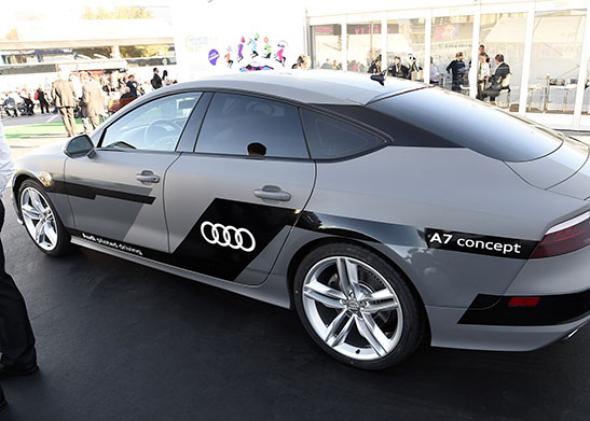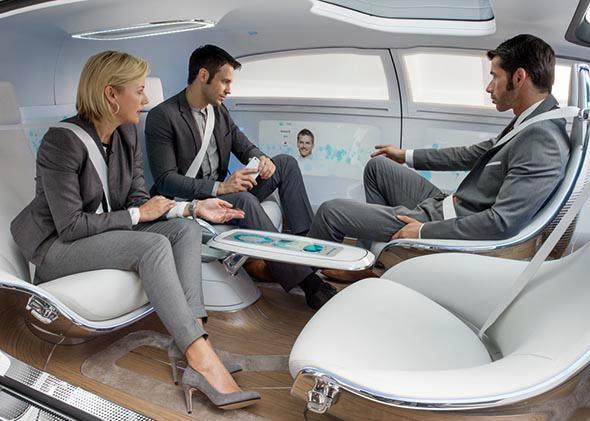Each year at the largest tech conference in the world, Nvidia hosts a press event to show off its latest chips and graphics processors. In past years at the Consumer Electronics Show in Las Vegas, it touted speedy new chips aimed at smartphones, tablets, and game systems. This year, however, its show revolved around what appears to be the next big mobile computing platform: the car.
Within a few years, CEO Jen-Hsun Huang said, “There will be more computing horsepower inside a car than anything you currently own today.” In a way, this makes sense. Cars are much bigger than tablets or smartphones, so they can accommodate far more powerful onboard computers. But wait: What will we do with all that power when we’re sitting behind the wheel? Surely we’re not going to be playing video games while weaving through traffic, right?
Actually, we just might. The stars of Nvidia’s show were a pair of computing platforms called Drive CX and Drive PX, both of which are built for cars—and could have us kicking back in our automobiles sooner than you think.
It wasn’t just Nvidia. This year’s CES was surprisingly dominated by automotive technology, from a self-driving Audi to a hydrogen-powered Toyota to more dashboard entertainment systems than anyone could count. CES, it seems, is becoming not just a tech show but an auto show—and the world’s car companies are eager to be seen as tech companies once again.
But let’s go back to Nvidia for a moment, because it’s tech like theirs that will make the future of cars possible. Drive CX, the company explained, is a “digital cockpit computer” that will power an in-dash, Internet-connected touch screen, rearview video cameras, individual “infotainment” displays for each passenger, and more. This type of system was all over the place at the CES in 2015, with Qualcomm, Panasonic, Ford, and others showing off their latest “connected car” technology. It isn’t exactly revolutionary: Early versions of these systems already exist in many of today’s cars, including the Tesla Model S, whose in-dash touch-screen control center is in fact powered by Nvidia.
Judging from this year’s CES, they’ll soon be ubiquitous. The dashboard, it seems, is the new tablet.
But it’s the second system, Drive PX, that points to a wholesale transformation of the driving experience. Nvidia calls it an “auto-pilot car computer.” The system, with an impressive two teraflops of processing power, is optimized for computer vision—the ability for a computer to process images and video and make sense of it in much the same way that the human brain does. In particular, Nvidia says it’s designed to facilitate what techies call “deep learning,” a branch of artificial intelligence in which algorithms come to recognize patterns and form connections between concepts.
One famous experiment in deep learning had Google supercomputers teaching themselves to identify cats in YouTube videos. What Nvidia has in mind is not so different: It’s about cars learning to identify stoplights, lane markings, pedestrians, and obstacles in the road in real-time videos streaming in from an array of cameras attached to the cars. It is, in other words, a potentially major step on the road to self-driving vehicles.
Other steps on that road abounded at this year’s conference. Among the most interesting, if unheralded, was a new LIDAR system from a two-year-old Silicon Valley startup called Quanergy. The company’s CEO, Louay Eldada, told me its solid-state sensors can provide the data needed for a self-driving car far more cheaply than Google’s Velodyne-powered system. It already has deals with Mercedes-Benz, Hyundai, and Renault–Nissan, a rarity for a startup so young. It’s a signal of just how fast the race to autonomous vehicles is beginning to unfold.
That doesn’t necessarily mean we’ll be ceding full control of our cars to computers anytime soon. As Lee Gomes argued recently in Slate, fully autonomous vehicles like Google’s still have a long way to go before they can safely navigate unfamiliar roads.
Yet Google’s audacious efforts have forced just about every major automaker to take notice, in one way or another. And they were out in force at CES this year, eager to prove that the autopilot revolution won’t leave them behind.
The boldest statements came from a pair of German automakers.

Photo by Robyn Beck/AFP/Getty Images
Audi rolled into Las Vegas with an A7 that had driven itself there from Palo Alto, more than 500 miles away. The car wasn’t fully in charge at all times, notes Wired’s Alex Davies, who sat behind the wheel for part of the trip. Audi’s technology is designed to take over for long stretches of highway, leaving unpredictable local roads and unforeseen circumstances to human expertise. Audi calls it “piloted driving,” and it’s an advanced form of the adaptive cruise-control systems that automakers are already beginning to offer. The company believes the technology will be built into its new cars by 2020, if not before.
Further down the road is the radical vision presented by Mercedes. The 89-year-old luxury automaker arrived at CES with a new, wildly futuristic concept car that imagines what vehicles will look like when the computers take over entirely. The vehicle, awkwardly dubbed the F 015 Luxury in Motion, featured a loungelike interior in which four swivel seats can be turned toward each other while the vehicle pilots itself down the road.

Photo courtesy Daimler AG/Global Communications/Mercedes-Benz
So, one might ask while hopping into a Mercedes Z-Class in the year 2032: “Who’s up for a game of Final Fantasy XXIV?”
Toyota, meanwhile, countered Tesla’s push toward an electric-car infrastructure with its own ambitious vision for a “hydrogen-powered society.” The hydrogen fuel cell Toyota Mirai, already on sale in Japan and due out in the United States later this year, will require an extensive refueling network of its own. So, following Tesla’s lead, Toyota announced at CES 2015 that it’s opening up thousands of its fuel cell patents in hopes of jump-starting innovation in the sector.
Detroit’s big three also made their presence known at the conference, albeit with somewhat less inspiring wares.
Chrysler focused on its connected-car apps, which felt a little desultory given what its rivals were up to. But Ford had a keynote speech, with CEO Mark Fields outlining a relatively conservative road map to autonomous vehicles. The company won’t build a self-driving car anytime soon, he said, although he does believe it will happen someday. For now it’s focused on driver-assistance features like self-parking and adaptive cruise control. Fields also announced a “smart mobility plan” comprising 25 separate experiments around the world designed to address the transportation needs of the future. They include a car-sharing program for workers at the company’s Dearborn, Michigan, headquarters and an app that finds open parking spots in London.
General Motors, meanwhile, jumped the starting gun on next week’s North American International Auto Show in Detroit by rolling out its next-generation Chevy Volt at a CES press event on Sunday. It offered few details about the car, other than to point out that it is the top-selling plug-in hybrid on the market. Still, it was another signal that CES is becoming a major event on automakers’ annual schedules.
To me, that was among the most interesting takeaways from the weeklong convention, whose prestige has eroded in recent years as the biggest technology companies have shied away. In 2011, my former Slate colleague Farhad Manjoo called CES “the most useless week in tech,” bloated with vaporware and bogus trends. The vaporware and bogus trends have not gone away. But the absence of the Apples, Microsofts, and Googles from CES also leaves the stage open for surprising developments from unexpected corners of the tech world. This year, the auto industry seized the spotlight.
The automobile is, after all, one of modern society’s most important technologies. But the sector was so bereft of genuine innovation for so long that we no longer think of car companies as part of the technology business. The major automakers are finally being shaken from their stupor, thanks to a big push from auto industry upstarts and outsiders like Google, Tesla, and Uber, who have each jolted the industry in its own way. If CES 2015 is remembered for anything, it could be as the year the car companies woke up.
Correction, Jan. 20, 2015: This article originally misidentified Unreal Engine 4 as a video game. It is a suite of software tools for game developers.
